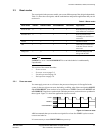
Processor Initialization, Resets, and Clocking
ARM DDI 0363E Copyright © 2009 ARM Limited. All rights reserved. 3-4
ID013010 Non-Confidential, Unrestricted Access
DMA into TCM
The SoC includes a Direct Memory Access (DMA) device that reads data from a
ROM, and writes it to the TCMs through the AXI slave interface.
Write to TCM directly from debugger
A Debug Access Port (DAP) in the system is used to generate AMBA
transactions to write data into the TCMs through the AXI slave interface. This
DAP is controlled from the debug host through a JTAG chain.
Preloading TCMs with parity or ECC
The error code or parity bits in the TCM RAM, if configured with an error scheme, are not
initialized by the processor. Before a RAM location is read with ECC or parity checking
enabled, the error code or parity bits must be initialized. To calculate the error code or parity bits
correctly, the logic must have all the data in the data chunk that those bits protect. Therefore,
when the TCM is being initialized, the writes must be of the same width and aligned to the data
chunk that the error scheme protects.
You can initialize the TCM RAM with error checking turned on or off, according to the rules
below see. See Auxiliary Control Registers on page 4-38. The error code or parity bits written
to the TCM are valid even if the error checking is turned off.
If the slave port is used, write transactions must be used that write to the TCM memory as
follows:
• If the error scheme is parity, any write transaction can be used.
• If the error scheme is 32-bit ECC, the write transactions must start at a 32-bit aligned
addresses and write a continuous block of memory, containing a multiple of 4 bytes. All
bytes in the block must be written, that is, have their byte lane strobe asserted.
• If the error scheme is 64-bit ECC, the write transactions must start at a 64-bit aligned
addresses and write a continuous block of memory, containing a multiple of 8 bytes. All
bytes in the block must be written, that is, have their byte lane strobe asserted.
If initialization is done by running code on the processor, this is best done by a loop of stores
that write to the whole of the TCM memory as follows:
• If the error scheme is parity, or no error scheme, any store instruction can be used.
• If the scheme is 32-bit ECC, use Store Word (STR), Store Two Words (STRD), or Store
Multiple Words (STM) instructions to 32-bit aligned addresses.
• If the scheme is 64-bit ECC, use STRD or STM, that has an even number of registers in
the register list, with a 64-bit aligned starting address.
Note
You can use the alignment-checking features of the processor to help you ensure that memory
accesses are 32-bit aligned, but there is no checking for 64-bit alignment. If you are using STRD
or STM, an alignment fault is generated if the address is not 32-bit aligned. For the same
behavior with
STR
instructions, enable strict-alignment-checking by setting the A-bit in the
System Control Register. See c1, System Control Register on page 4-35.
If the error scheme is 64-bit ECC, a simpler way to initialize the TCM is:
• Turn off error checking.


















